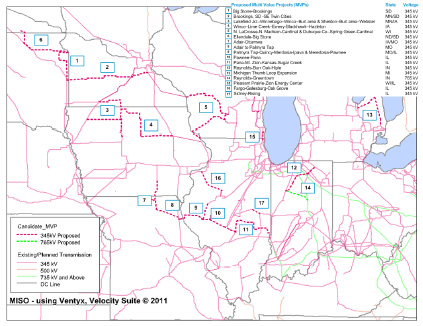MTEP 11 steamrolling its way across the Midwest
Here it is, MTEP 11, the Midwest Transmission Expansion Plan for 2011 (CLICK HERE, look on lower right), and it’s in the news too. The main report and some appendices:
MTEP 11 Appendix A-1_2_3 – Cost Allocation
Page listing all the Appendices
MTEP Appendix e52 Detailed Proposed MVP Portfolio Business Case
Please take note that this includes not only the CapX 2020 Brookings-Hampton line (#2 on map), but also the LaCrosse-Madison line (#5 on map), the one they need to build or they’ve got a lot of system instability goin’ on.
From my perspective, the most important thing to be aware of is that MTEP 11, and the MTEPs that preceded it, are about the shift to economic dispatch and development of the electric market. At the outset, MISO studied potential benefits of this shift, and found massive economic benefits, of which they speak in their press release. The economic benefits are realized by optimizing use of lower production cost generation, and in their own words, to “displace natural gas with coal.â€Â Don’t believe it? Read this study that ICF did for MISO:
This is the worst possible result for those of us who breathe, and means that tens of thousands of landowners will have very high voltage transmission lines on their land, taken from them by eminent domain. These projects, almost all of the MTEP projects, are not about electric reliability, they’re “need†is to deliver market transactions of electric generation from any “point A†to any “point B,†and this is a private interest, a desire for market profits, and not a public interest.
Another issue looming is “what does MISO ‘approval’ mean?â€Â Transmission lines are regulated by states, individually, and there is a movement to strip states of their regulatory authority and transfer that to federal entities. Look no further than Obama’s transmission “fast track†proposal, naming one of the CapX 2020 projects! States must make their energy regulatory decisions in an open, transparent process and based their decisions on ratepayer and public interest. That focus is not present in federal top-down edicts. States’ rights are at issue and we need to keep on our toes so this power shift doesn’t slide through.
And it’s not “just” the ICF report above, that’s it’s all about coal is clear from prior press. Here’s an important sentence, quoting GRE’s spin-guy Randy Fordice — explaining what we all know, that the MISO effort to get the “benefits†of displacing natural gas with coal:
Coal with benefits, yesiree…Â Gotta hand it to Fordice for being honest!
Here it is in the news:
Wind? NOT! Recall that honest quote from Fordice, above!
And in the St. PPP:
Power line project to Dakota County clears last hurdle
By Leslie Brooks Suzukamo
lsuzukamo@pioneerpress.com
Updated: 12/08/2011 10:22:15 PM CSTMinnesota has the region’s strongest renewable energy mandate, requiring its utilities generally to provide 25 percent of their energy from renewables by 2025.
The mandate puts a heavier burden upon its largest utility, Minneapolis-based Xcel Energy, requiring it to derive 30 percent of its power from renewables by 2020.
The unanimous vote by the MISO board in Carmel, Ind., marked the first time the grid operator took into account the policy needs of states, said Beth Soholt, executive director of Wind on the Wires, a St. Paul advocacy group for wind energy.
“I would call it historic,” she said. Before this, MISO primarily focused on the reliability of the grid and not concerned with the kind of power transmitted over it, she said.
MISO’s approval will make it easier for Minnesota to export wind energy in the future, MISO vice president of transmission asset management Clair Moeller said in a press conference.
Although the MISO board’s decision approves 215 projects worth $6.5 billion, the 17 green power projects like the Brookings line account for $5.2 billion of the cost.
Ultimately, ratepayers will pay for all these projects, but so-called multivalue projects like the Brookings Line carry a tariff that spreads the cost across MISO’s 12 states and the Canadian province of Manitoba.
So, instead of Minnesota being saddled solely with the cost of the Brookings Line, states as far away as Michigan will help shoulder the burden. And vice versa.
The MISO board reasoned that all states benefit from these projects, because they strengthen the grid, shoring up aging infrastructure. They also allow states to add renewable energy and clear out congestion on the lines so states can have better access to cheaper electricity when they need it, which makes the grid more efficient.
“It’s hooking up Midwest power to meet Midwest needs,” Soholt said. The grid MISO operates stretches from the Dakotas to Michigan and Manitoba to Indiana.
The projects “will allow the region to build a robust transmission grid that will bring reliability and economic benefits to the region as well as smoothing the way for the Midwest to tap its considerable wind resources,” said Rob Gramlich of the American Wind Energy Association.
In other states, some projects will next have to undertake lengthy regulatory approval.
Last year, some states in MISO had balked at the new Multi-Value Projects tariff, saying they were too far from Minnesota and the Dakotas to benefit from their wind power on the grid.
But other Midwestern states have already started tapping into the prairie winds. Indiana Power and Light Co. has a purchase agreement with a wind farm in Lakefield in southwest Minnesota.


Comments
MTEP 11 steamrolling its way across the Midwest — No Comments
HTML tags allowed in your comment: <a href="" title=""> <abbr title=""> <acronym title=""> <b> <blockquote cite=""> <cite> <code> <del datetime=""> <em> <i> <q cite=""> <s> <strike> <strong>